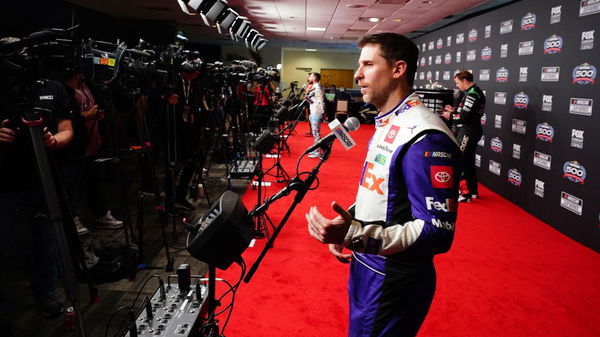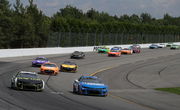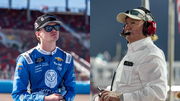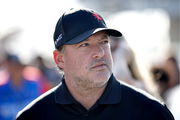

“We look at the sport and the personalities that you have inside our sport, and there’s a select few, and I feel like I’m near the top of the list of just being personable and likeable despite all the BS that goes on,” declared Bubba Wallace. NASCAR enthusiasts have cried out for years, mourning the loss of the brash, charismatic personalities that once dominated the sport. Dale Earnhardt’s menacing presence, Tony Stewart’s explosive eruptions–all a distant memory. The drivers today are undoubtedly good, dominating tracks with precision and skill, yet many fans find them lacking the charm to make them icons. But one active driver has everything that shouts ‘personality’.
Denny Hamlin owns his in-your-face approach, with retired driver Michael Waltrip complimenting him as “always right” and one of the few voices not afraid to ruffle feathers. But the question persists: why don’t the younger drivers in NASCAR command the same kind of attention as the ones who came before them? Drivers such as Kyle Larson, Christopher Bell, and Chase Elliott always bring the goods on the track, but their off-track presence tends to be muted, leaving fans hungry for more. Seasoned broadcaster Mike Joy, a respected voice in NASCAR, has an unexpected explanation that captures fans’ frustrations but deflects blame from the drivers themselves.
ADVERTISEMENT
Article continues below this ad
Mike Joy blames technology for the current depletion of personality
In a candid discussion with former driver Kevin Harvick, Joy zeroes in on a culprit we all carry: the cell phone. Harvick, now a commentator, sees immense potential in the sport’s young talent, arguing that NASCAR is full of “great personalities” who are simply maturing. “We have a lot of kids that are maturing into being adults,” said Harvick. “I think that makes a big difference in how you express yourself and the things that you’re willing to say.” He points to drivers like Bell and Larson, who’ve grown into leaders over time, as proof that patience is key. Harvick even challenged the narrative that Chase Elliott is the sport’s most popular driver, suggesting others could rise with the right exposure.
Joy, however, believes there’s a deeper barrier stunting this growth. “I would [agree with Harvick], but I think that maturing process is hindered by what is permanently attached to our pocket and that’s the cell phone,” Joy explains. “A lot of these younger drivers… their social skills have pretty much been determined by their cell phones, and that’s their interaction with their peers. People skills and media skills take a while to develop.” He uses Christopher Bell as a prime example: “He wasn’t even on our radar the first couple of years in Cup because he wasn’t out with the media, you know. His personality, his external personality, took a while to develop.” Now, Bell is a confident spokesman, but Joy notes it took years for him to break out of his shell. Larson, too, has only recently become a vocal leader, despite his on-track dominance. Joy argues this delay is a pattern, driven by a generation raised on screens, where real-world interactions take a backseat to curated social media posts.
Some point to the sport’s changing culture, where sponsor-driven professionalism can mute raw personality. Even YouTube star Cleetus McFarland, whose viral, high-energy style has injected fresh excitement into NASCAR events, highlights how a bold personality can draw crowds in ways many current drivers don’t. So, what’s holding these young racers back from becoming the larger-than-life stars fans want? The evidence is compelling.
Young drivers are often tethered to their phones, communicating through X posts or Instagram stories rather than unscripted, face-to-face moments. This digital filter can dilute the raw, authentic energy fans crave, replacing it with polished, sponsor-friendly content. NASCAR president Steve Phelps has echoed these concerns, questioning whether the sport’s younger stars have the personality to sustain its future. Phelps’ doubts, noting how the lack of outspoken drivers could hurt NASCAR’s appeal. Meanwhile, the rise of figures like McFarland, whose unpolished charisma has drawn massive crowds, underscores what NASCAR might be missing. McFarland’s journey from YouTube prankster to NASCAR influencer shows how a vibrant personality can captivate audiences in ways many drivers struggle to.
Joy’s critique isn’t about dismissing the talent in NASCAR’s garage. “We have stars, we have great drivers in this series,” he insists. “And I guess it’s up to you, me, and the people that will follow us this season to make heroes out of them.” He’s calling on broadcasters, journalists, and fans to bridge the gap, helping drivers step out from behind their screens. This is no small challenge in a world where every word is scrutinized online, and drivers face pressure to stay “safe” to avoid controversy. For younger drivers, finding that balance—being authentic without alienating sponsors or fans—is a tightrope walk.
Cell phones and social media may be the culprits, shaping a generation more comfortable texting than talking, but the solution lies in collective effort. By giving drivers like Bell, Larson, or even Wallace the space to grow, make mistakes, and find their voice, NASCAR can nurture its next wave of heroes. The talent is there, waiting to break free from the digital cocoon. If the sport can help these racers shine beyond the track, NASCAR might just rediscover the electric personalities fans have been missing. But, what if social media helps a driver to make it to the track?
ADVERTISEMENT
Article continues below this ad
What’s your perspective on:
Are cell phones killing NASCAR's charisma, or is it just a generational shift in personality?
Have an interesting take?
Trending
NASCAR female driver’s unorthodox road to glory
Toni Breidinger is racing her way into history, and her story hits right in the heart. As the first Arab-American woman in NASCAR, she’s not just driving—she’s carving her own path. Growing up in a male-dominated sport, Toni faced doubts but turned them into fuel. That grit led her to break records, with 19 top-10 finishes in the ARCA Menards Series. But this rise to public attention is a gift of her TikTok and Instagram popularity. However, this was only possible because she was passionate.
She was so sure of herself and what she wanted in life from a very young age. “I remember I came to my parents with this document saying, “This is what I need to do, this is my plan on how I’m going to become a NASCAR driver,” she said, “So when I was 17, I told them, ‘Once I graduate high school, I’m going off, going to move to North Carolina and try to be a NASCAR driver.”
ADVERTISEMENT
Article continues below this ad
Toni’s journey isn’t just about speed—it’s about heart. “Honestly, I kind of just winged it, but thankfully it’s worked out,” she graciously confessed. Her family’s support keeps her grounded, and every race is a chance to honor them. As she gears up for more NASCAR victories, Toni’s story reminds us: courage and hard work can take you anywhere. She’s not just racing—she’s rewriting what’s possible.
ADVERTISEMENT
ADVERTISEMENT
ADVERTISEMENT
ADVERTISEMENT







Are cell phones killing NASCAR's charisma, or is it just a generational shift in personality?